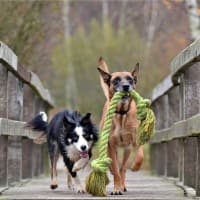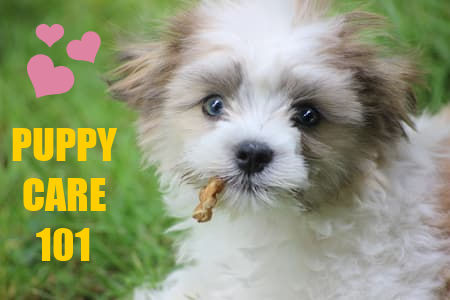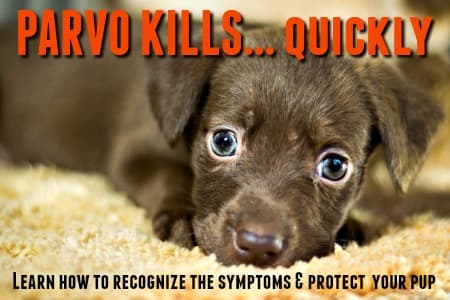FYI: If you buy something through a link on this site I may earn a commission - at NO extra cost to you.
Big Dog Health Problems
If you're the proud owner of a large, extra-large or giant breed, there are a range of big dog health problems that you need to be aware of.
Although these large dogs tend to look strong and robust, and even as puppies they're often built like tanks, it's important for dog owners to realize that they're still at risk for developing some very specific health issues and this page takes a look at some of the most common problems below.
Although these common health problems are NOT entirely exclusive to large, extra-large or giant dogs, many of them are most often seen in these groups. Some examples of larger breeds include German Shepherds, Labrador Retrievers, Rottweilers, Doberman Pinschers, Bernese Mountain Dogs, Great Danes, Saint Bernards, Irish Wolfhounds and Mastiffs).
Of course small breeds have their own unique health challenges (especially when you start to look at the tiny/teacup varieties) and those at the top or bottom of the size-scale seem to fare the worst.
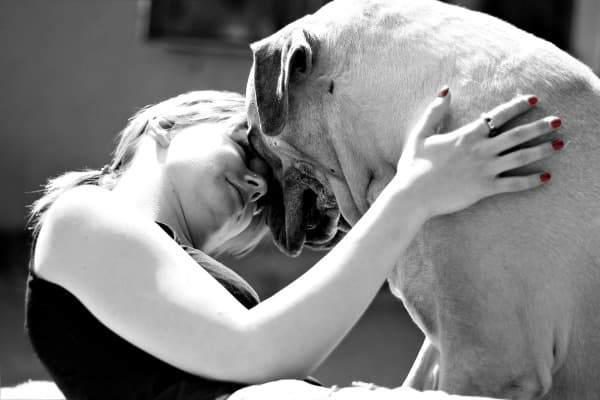
Pet parents who are aware of the risks, and know what to do if problems do show up, gives your big 'un the best chance at living a long, happy and healthy life. This page covers many of the most common health issues faced by large dog breeds and their extra-large or giant cousins.
- Life expectancy for large breed dogs
- Bone, joint & ligament issues
- Heart condition
- Other 'big dog' health problems
Big Dogs - Lifespan & General Health
It's a fact of life that large and giant breed dogs tend to live for significantly fewer years than the medium to small breeds.
The average life expectancy for a Great Dane falls somewhere between 7 - 10 years, for a Rottweiler 9 years is about average.
Compare this to smaller breeds who routinely live to be 12 - 15 years old and you can see the difference.
Although you can't change these facts, you can help your big pup/dog maximize his potential for a long, happy, healthy life by:
One of the best things you can do is to make sure that he has a high-quality diet and eats a premium quality dog food formulated for his specific nutritional needs
Adequate, and appropriate, exercise to keep him at a healthy weight which will avoid putting on extra pounds which can put too much strain on growing bones/joints too early on.
This is crucially important with large, X-large and giant breed puppies. It's also important to keep large and extra-large breed puppies on the 'lean' side during this period. Excess pounds put additional strain on their growing frame and muscle structure and can also be the cause of joint damage.
An overweight dog (regardless of breed size) is also at risk of heart problems, diabetes and other conditions in pretty much the same way humans are. So keeping your eye on your dog's weight is always important. Bigger isn't better, so never try to make your large-breed puppy grow bigger, or faster, than he is naturally inclined to do. It's a recipe for trouble!
Provide regular veterinary care throughout his lifetime, including appropriate vaccinations, keeping current with parasite prevention, ensuring good dental health and getting annual check-ups.
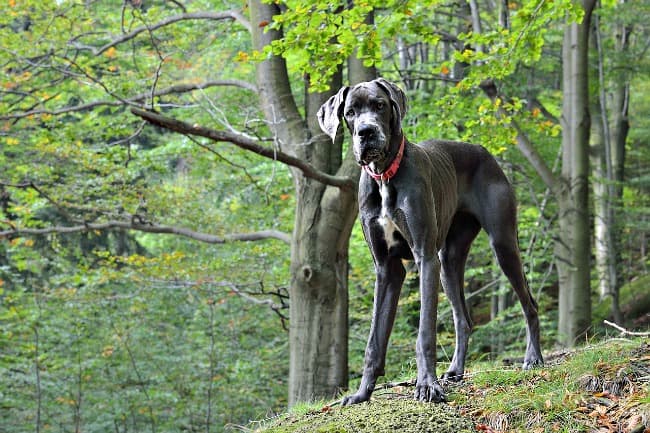
Large and giant breeds can be much more fragile than they look.
Some of them (including Rottweilers, Doberman Pinschers and 'bully breeds' such as Pitbulls) have immune systems that are especially vulnerable to the highly contagious and extremely dangerous Parvovirus. They can catch it very easily and react severely once infected.
Of course exercise is as important for keeping your XL best friend in good shape as it is for you, but it's important not to overdo it, especially with larger breeds.
This is because their bodies are growing at a phenomenal rate during the early months and bones, joints and ligaments can have trouble 'keeping up'. Which can result in sprains, tears, dislocations and other orthopedic problems.
Bones, Joints, Muscles & Ligaments
Big dogs can be surprisingly fragile when it comes to their skeletal frame, and bone or joint problems are fairly common.
The extra size/weight, plus the rapid growth that our big dogs experience in the first year play a big role in this, putting them at higher risk for orthopedic problems.
Here are some of the most common bone/joint problems seen in large breed dogs....
Dysplasia, Ligament Tears & Panosteitis
These include Hip and Elbow Dysplasia, which are orthopedic conditions caused by malformed or 'poorly fitting' hip or elbow joints.
Both canine hip dysplasia and elbow dysplasia can be genetic problems, or they can be caused by poor diet, jumping from height, or by exercising a growing puppy too hard/too much.
One of the best ways to make sure the puppy you choose is less likely to develop hip or elbow dysplasia is to make sure that you buy from a reputable, responsible breeder whose parent dogs (and preferably grand-parents and great-grandparents too) have an OFA certification of 'Good' or 'Excellent'.
This will go a long way to eliminating dysplasia that has a genetic component,.
Cruciate ligament damage (usually to the back leg in the 'knee' area) are fairly common. Can happen for no apparent reason, but uneven ground, turning abruptly, or falling can all cause it.
Panosteitis (often called 'Pano' or known as growing pains) is a condition caused by inflammation in the growing joints of a young or adolescent pup. It causes joint pain which results in lameness or limping.
Hypertrophic Osteodystrophy (or HOD) causes swollen/painful joints (often the lower joint in the front legs), and can be triggered by several things including infection, improper diet, vaccine reactions and more.
This condition can cause the joints to become malformed and your pup may 'knuckle-over' or his front legs may become bowed.
Wobblers Syndrome, also known as Spondylolitheses, this is one of the big dog health problems which affects some extra large breed dogs, including Great Danes, Doberman Pinschers, St. Bernards, Rhodesian Ridgebacks, Bernese Mountain Dogs, Rottweilers, Basset Hounds, Weimaraners, Dalmations and Borzois.. It is more common in males than in females.
This syndrome is caused by a narrowing or malformation of the vertebrae in the dogs neck, which puts pressure on the rest of the spine. This results in a slightly uncoordinated gait with short steps and a swaying, or wobbly movement, hence the name 'Wobbler Syndrome'.
There are two versions of this condition, one strikes early, affecting puppies (from as early as between three and five months old and usually before they reach eighteen months). The second one strikes later with symptoms showing in dogs who are middle-aged or seniors (usually at around four or five years of age).
There are no clear answers from experts as to what risk factors are related to Wobblers, obviously breed and genetics play a role, but improper diet, too-rapid growth and conformation issues may also be parts of the puzzle.
Treatment for Wobblers Syndrome is most often NSAID's to reduce inflammation and reduce the pressure on the spinal cord and nerves, combined with rest and a reduction in activity. Steroids may also be prescribed by your pet's veterinarian. In severe cases or when a puppy or dog doesn't respond to these treatments there are surgical options which vary depending on the variation and severity of the condition.
Patellar Luxation. A luxating patella is basically a hind leg kneecap which has slipped out of place, and it can happen to just one leg or both and is much more common in small dogs than in large ones. In small and tiny dogs the slipping of the kneecap happens inwards (or towards the opposite leg) whereas if it does happen in a big dog the slippage can also be outwards. Depending on how severe the luxation is treatment may include anti inflammatory medications, weight management, activity restrictions, physical therapy or surgery.
A nutritionally balance diet can help to prevent many bone/joint problems.
Canine Nupro Dietary Supplement is a totally holistic dietary joint supplement that contains vitamins, minerals, enzymes, amino acids, and essential fatty acids in natural raw forms.
It is an excellent addition to your dogs nutritional program and is suitable (and beneficial) for the joint health of puppies and dog of all ages.
Arthritis
Several big dog health problems involve bones/joints and ligaments, and in older dogs this can lead to arthritis.
Arthritis affects a lot of dogs, and it's not confined to large breeds. It usually shows up in older dogs, of any size, and gets worse with advanced aging
Big dogs are especially at risk because of their growth patterns and weight, plus they tend to show arthritis symptoms earlier than their more moderately sized cousins.
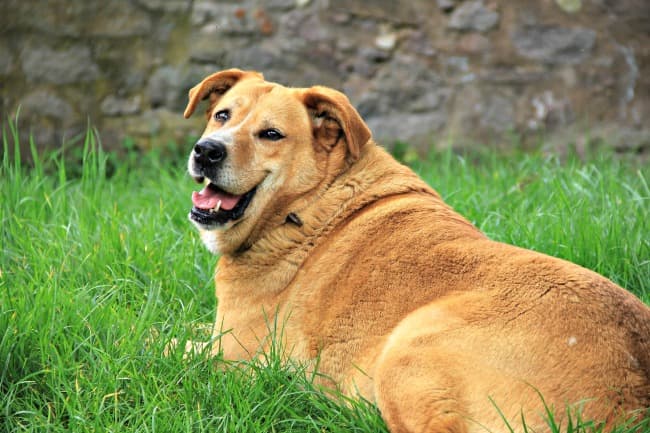
There are also several other things that contribute to, or accelerate, the onset of arthritic changes. These include:
- A genetic pre-disposition which can run through certain breeds and specific bloodlines within the same breed
- Very early spaying/neutering
- A diet which promotes too rapid growth, obesity or joint problems such as hip dysplasia
Symptoms of arthritis in dogs can include:
- Stiffness (especially first thing in the morning or after a nap)
- Limping or lameness
- A general slowing down of activity level and mobility
- Increasing difficulty in terms of movement (eg climbing stairs or getting in or out of the car)
- Exercise difficulties (reluctance to run/walk for long periods, no desire to play fetch etc.)
Although you can't prevent arthritis developing in later life, feeding a premium diet that is formulated for his breed type/size and keeping him 'lean' will definitely help slow down those changes.
Large and giant breed dogs, especially the guardian and working breeds, tend to have a high tolerance for pain and the signs that they're in discomfort may be very subtle!
Adding joint supplements to your mature dog's daily diet may also be a good idea as these can work to safeguard those joints, products such as Veterinarian's Best Hip Joint Advanced, Joint Rescue Super Strength Chewable or Agile Joints Arthritis Support are all good choices.
Gentle exercise, a memory foam and/or heated bed, carpeted floors or non-slip rugs/runners and elevated dog bowls can all make life more comfy for your arthritic pet. Physical therapy including water therapy and such can also be very helpful. Your pet's veterinarian may suggest pain medications, anti-inflammatories or other treatments depending on the severity of your dog's condition.
There are also treatment options including medications such as Rimadyl or Derramax (by prescription from your veterinarian) or Aspirin (preferably one that is specifically coated and formulated for dogs).
osteosarcoma (bone cancer)
Dogs of any age, size and breed can develop osteosarcoma, but large and giant breeds seem to be more prone to this type of cancer.
Results of a recent UK study led by the University of Bristol Veterinary School (and in collaboration with both Cardiff University in Wales, and the Royal Veterinary College of London), were published in March of 2021 and confirms that this painful and aggressive cancer is seen more often in certain large breed dogs. More about this study HERE
Some of the breeds at the highest risk appear to include the Rottweiler, Great Dane and Rhodesian Ridgeback. In addition, purebred dogs who are specifically bred to encourage a conformation with long legs or a large body mass and skull also have an elevated risk. The study tells us that genetics definitely play a role in the development of this disease.
At the other end of the spectrum, the breeds with the lowest risk of osteosarcoma tumors include the Bichon Frise, French Bullodog and Cavalier King Charles Spaniel.
General clinical signs of Osteosarcoma in dogs can include:
- Chronic limping or lameness (often first seen in the front legs)
- Swelling of bones and/or joings
- Loss of appetite
- Lethargy
- Visible growth or mass on the body/head
The front legs are the most common place for this canine osteosarcoma to start/be seen, but the spine, ribs and jaw are also frequent targets. Depending on where the tumor is growing, there may be additional symptoms, including:
- Difficulty breathing
- Difficulty chewing or swallowing
- Difficulty walking or balancing
- Wobbly or unsure gait
- Seizures
Canine Osteosarcoma is a dangerous and aggressive type of bone cancer and can metastasize (spread) to other parts of the body quickly. Because of this it's very important to get a diagnosis and treatment plan quickly.
Although the symptoms of osteosarcoma in dogs can be mild at first, and may mimic other conditions, it's important to have your dog examined by your veterinarian quickly if you notice any of them. It's always better to be safe than sorry.
There are various treatment options for osteosarcoma, the most common being surgery, followed by chemotherapy. Stereotactic radiation (SRS/SRT) may be used if the location of the tumor makes surgery difficult or when bone destruction is minimal.
This type of radiation is high dose, and highly accurate and results in an overall quicker and easier recovery than is seen with some other treatments. However it isn't a good choice for every situation or dog due to the progression/location of their tumor/s.
Your veterinary will recommend the best course of treatment for your dog based on the location and stage of tumor/s.
Learn more about canine osteosarcoma HERE.
Heart Problems In Large Breeds
There's a lot of strain on a big dog's heart... that large frame and weight needs a strong heart to support it.
Some heart conditions in big dogs are genetic, others can be caused by illness, infection, even parasites.
Age-related heart problems in dogs can occur (humans suffer from this issue too) in breeds of all sizes.
Dogs don't have 'heart attacks' the way humans do, but heart conditions can still be very serious, and potentially fatal.
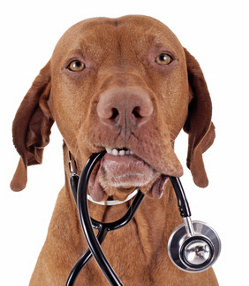
Dilated Cardiomyopathy
This is a heart condition, and a dog with DCM has heart muscles that don't contract efficiently, causing arrhythmia (irregular heartbeats).
It also means that the heart has to work extra-hard to pump blood around the body and this puts an immense strain it.
Most commonly seen in extra large breed dogs, especially Great Danes, Irish Wolfhounds, Scottish Deerhounds, Doberman Pinschers, St Bernards and Newfoundlands.
A dog can show no symptoms and die suddenly from this condition, although sometimes dogs show symptoms such as excessive panting, trouble breathing, heavy or rapid breathing and are often fatigued and easily tired.
Severity of the condition varies, as does the treatment and prognosis for individual dogs.
An echocardiogram, chest x-rays and an EKG can help diagnose this condition.
There's a natural product that can help promote healthy cardiac function in your dog. It's called Young at Heart for Dog Heart Disease and it's a totally herbal formula, free of all chemicals.
You can help your dogs' heart stay strong and healthy, and improve his overall vitality by adding Hearty Heart to his daily regimen.
aortic stenosis
This is another heart condition that is more commonly seen in extra large or giant dog breeds.
AS and SAS (Sub Aortic Stenosis) are caused by a narrowing of the aorta, which affects blood flow and puts extra strain on the heart.
Limiting exercise and stress in affected dogs can help reduce the risks associated with this condition, but it does vary in severity and can cause sudden death. Surgeries such as cardiac catheterization can also be undertaken on dogs with aortic stenosis and other valvular heart issues.
Aortic Stenosis
This is another heart condition that is more commonly seen in extra large or giant dog breeds.
AS and SAS (Sub Aortic Stenosis) are caused by a narrowing of the aorta, which puts extra strain on the heart.
Limiting exercise and stress in affected dogs can help reduce the
risks associated with this condition, but it does vary in severity and
can cause sudden death.
heartworms
These are internal parasites which are transmitted by mosquitoes, and can affect ANY dog, of any breed/size/age.
Most heartworm infestations in dogs don't show symptoms until the condition is advanced, sometimes too late to be treated.
Even if it's not too late, heartworm treatment is long, painful and expensive.
It's MUCH easier to prevent heartworm than to treat it. Giving your dog a monthly heartworm preventative is quick and easy, and could literally save his life.
Other Big Dog Health Problems
There are several other health conditions which occur in big dogs, but not necessarily exclusively.
Dogs of any size/breed could potentially develop them too.
Hypothyroidism
This is a condition of the thyroid gland, where it produces too little of the hormone thyroxin.
It's fairly common in some giant breed dogs and symptoms include unexplained weight gain, lethargy and skin conditions such as thinning hair, darkened skin, itching and so on.
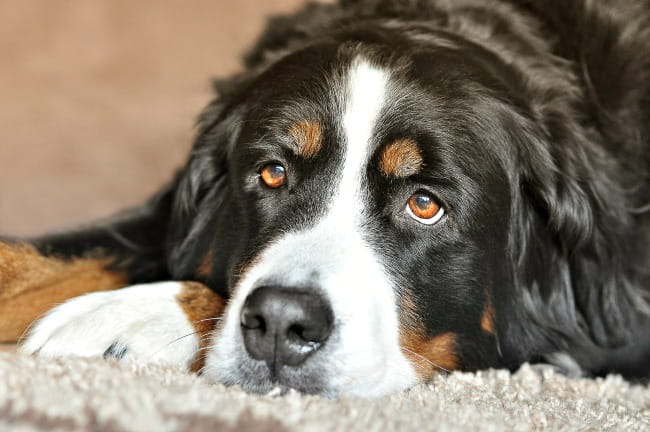
Hypothyroidism
in dogs is usually treated with hormone supplementation.
If you'd prefer to try the natural approach to your dogs thyroid problems, try
Canine Thyro-up for Dog Hypothyroidism. This all-natural, herbal product contains no synthetic hormones, has no harmful side effects and is safe for long-term use.
Bloat or Torsion
This is a very serious condition and is also known as Gastric Dilatation Volvulus or GDV (not Gastric Dilation, that is a misspelling) It's a condition that mostly affects large, deep-chested dog breeds including Great Danes, Greyhounds, Bullmastiffs, and St. Bernards (among others).
Smaller dogs who have big/deep rib-cages are also at risk, Dachshunds are an example of these.
It's a condition where a dog's stomach stretches either because of too much food/water or gas, as it extends there is a risk that it will twist or flip into an unnatural position, basically cutting off the passages between the stomach and the esophagus and the stomach and the intestines.
This is life-threatening and, unless recognized and treated quickly, is often fatal.
The causes of bloat aren't fully understood, but there are some things that seem to trigger it. These include:
- Eating too much at one sitting (especially common if the dog is fed once a day)
- Eating too fast
- Drinking a lot of water very quickly
- Indulging in vigorous exercise too soon after eating/drinking
Bloat symptoms include:
- Excessive panting
- Panting or whining
- Drooling
- Retching or dry heaving
- Vomiting (although your dog may not actually bring back up any food due to the twisted stomach)
- A swollen or distended belly
If you notice any of these symptoms, get your dog to a veterinarian or emergency animal hospital IMMEDIATELY. For an in-depth look at bloat (including causes, symptoms and treatment) check out this page .
Although they're by no means guaranteed to prevent bloat, using elevated dog bowls for your big guy's food and water can help minimize risks.
This is because they make it easier for your dog to eat in a comfortable position and reduce the amount of air he swallows (a factor in triggering bloat).
If you have a 'chow hound' who guzzles his food, a 'go-slow' or 'anti-gulp' type of dog bowl (such as the Healthy Diet Slow-Eating Anti-Gulping Dog Food Bowl) can also help.
Entropion & Ectropion
These are conditions affecting the eyes, to be more precise the eyelids of big dogs
In Entropion, the eyelid rolls inwards and fur or eyelashes irritate the cornea, if left uncorrected it can cause infection/irritation and vision problems.
It's more commonly seen in giant dog breeds such as Mastiffs, Great Pyrenees, Newfoundland, Bernese Mountain Dog, Great Dane and St. Bernard.
Ectropion is not seen as often in the extra large breed dogs, but it can occur in the same breeds affected by Entropion.
Ectropion is caused when the eyelid rolls outwards or droops.
This can cause infection, inflammation, conjuctivitis and more.
Both conditions can be corrected with a simple surgery, and Ectropion can sometimes be treated with eyedrops and other medications.
Cherry Eye
Although this doesn't happen only in only large breeds, Cherry Eye is a problem that can affect all types of Mastiffs as well as Bloodhounds, Shar Peis, Saint Bernards and more.
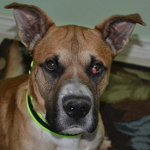 My dog, Ivan, before Cherry Eye surgery
My dog, Ivan, before Cherry Eye surgeryCherry Eye happens when the gland in the third eyelid becomes inflamed and enlarged, causing a red, swollen lump to appear in the inner corner of your dogs eye.
Although it's not a life-threatening condition, left untreated it can cause discomfort, pain, infection and potentially damage his eyesight.
There are treatment options available, check out this page to learn more and to read about one of my dog Ivan's 'up-close-and-personal' experience with this condition.
It's not possible to cover all the health issues that big dogs can experience, there are just too many variables and each breed has their own unique strengths and weaknesses however the information on this page can help you minimize the risks and also recognize potential trouble early on... when treatment is most effective.
Good luck with your big guy or girl!
you might also like...
- Home
- Dog Health Information
- Big Dog Health Problems
FTC Disclosure: Some pages on this site contain affiliate links. I may earn on qualified purchases.



